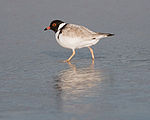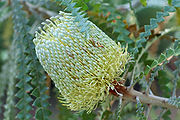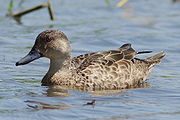
Lake Warden (Western Australia)
Encyclopedia




Lake
A lake is a body of relatively still fresh or salt water of considerable size, localized in a basin, that is surrounded by land. Lakes are inland and not part of the ocean and therefore are distinct from lagoons, and are larger and deeper than ponds. Lakes can be contrasted with rivers or streams,...
in the Goldfields-Esperance region of Western Australia
Western Australia
Western Australia is a state of Australia, occupying the entire western third of the Australian continent. It is bounded by the Indian Ocean to the north and west, the Great Australian Bight and Indian Ocean to the south, the Northern Territory to the north-east and South Australia to the south-east...
. It and its associated wetlands are protected in a nature reserve
Nature reserve
A nature reserve is a protected area of importance for wildlife, flora, fauna or features of geological or other special interest, which is reserved and managed for conservation and to provide special opportunities for study or research...
; they were recognised as being of international importance under the Ramsar Convention
Ramsar Convention
The Ramsar Convention is an international treaty for the conservation and sustainable utilization of wetlands, i.e., to stem the progressive encroachment on and loss of wetlands now and in the future, recognizing the fundamental ecological functions of wetlands and their economic, cultural,...
through designation of the Lake Warden System on 7 June 1990 as Ramsar Site 485. The lake is also a DIWA-listed wetland
A Directory of Important Wetlands in Australia
A Directory of Important Wetlands in Australia is a list of wetlands of national importance to Australia. Intended to augment the list of wetlands of international importance under the Ramsar Convention, it was formerly published in report form, but is now essentially an online publication...
.
Location
The lake is about 5 kilometres (3 mi) north of EsperanceEsperance, Western Australia
Esperance is a large town in the Goldfields-Esperance region of Western Australia, located on the Southern Ocean coastline approximately east-southeast of the state capital, Perth. The shire of Esperance is home to 9,536 people as of the 2006 census, its major industries are tourism, agriculture,...
, between the two main access roads to the town, the South Coast
South Coast Highway
South Coast Highway is a Western Australia highway. It is a part of the Highway 1 network.With a length of , it runs from Esperance to Walpole roughly in parallel to the Western Australia's south coast...
and Coolgardie-Esperance Highway
Coolgardie-Esperance Highway
The Coolgardie–Esperance Highway is a 368 km Western Australian highway between Coolgardie and Esperance. It runs in a north-south direction linking the WA's Eastern Goldfields to the coast....
s. It lies in the Esperance Plains
Esperance Plains
Esperance Plains, also known as Eyre Botanical District, is a biogeographic region in southern Western Australia. Located on the south coast between the Avon Wheatbelt and Hampton regions, and bordered to the north by the Mallee region, it is a plain punctuated by granite and quartz outcrops and...
IBRA
Interim Biogeographic Regionalisation for Australia
The Interim Biogeographic Regionalisation for Australia is a biogeographic regionalisation of Australia developed by the Australian Government's Department of the Environment, Water, Heritage and the Arts...
bioregion
Ecoregion
An ecoregion , sometimes called a bioregion, is an ecologically and geographically defined area that is smaller than an ecozone and larger than an ecosystem. Ecoregions cover relatively large areas of land or water, and contain characteristic, geographically distinct assemblages of natural...
, and in the Esperance Lakes Nature Reserve.
Description
The lake has an average depth of 2 m, which has been slowly increasing since recording first began in 1979. The average depth of the lake is now more than one metre higher than it was, mostly as a result of deforestationDeforestation
Deforestation is the removal of a forest or stand of trees where the land is thereafter converted to a nonforest use. Examples of deforestation include conversion of forestland to farms, ranches, or urban use....
that has led to a greater amount of run-off
Surface runoff
Surface runoff is the water flow that occurs when soil is infiltrated to full capacity and excess water from rain, meltwater, or other sources flows over the land. This is a major component of the water cycle. Runoff that occurs on surfaces before reaching a channel is also called a nonpoint source...
. As well as Lake Warden itself, the 2000 ha Ramsar site includes the associated system of saline
Salinity
Salinity is the saltiness or dissolved salt content of a body of water. It is a general term used to describe the levels of different salts such as sodium chloride, magnesium and calcium sulfates, and bicarbonates...
lakes and marsh
Marsh
In geography, a marsh, or morass, is a type of wetland that is subject to frequent or continuous flood. Typically the water is shallow and features grasses, rushes, reeds, typhas, sedges, other herbaceous plants, and moss....
areas behind beach-front dune
Dune
In physical geography, a dune is a hill of sand built by wind. Dunes occur in different forms and sizes, formed by interaction with the wind. Most kinds of dunes are longer on the windward side where the sand is pushed up the dune and have a shorter "slip face" in the lee of the wind...
s. The Lake Warden system is hydrologically
Hydrology
Hydrology is the study of the movement, distribution, and quality of water on Earth and other planets, including the hydrologic cycle, water resources and environmental watershed sustainability...
complex with seven main lakes and over 90 smaller lakes creating diverse wetland habitats. As well as Warden, significant lakes in the system include Windabout, Woody, Station, Mullet and Wheatfield Lakes.
The catchment for the lake covers an area of 212000 hectares (523,863 acre) of which 80% is agricultural land, of which 95% has been cleared
Land clearing in Australia
Land clearing in Australia describes the removal of native vegetation and deforestation and in Australia. Land clearing involves the removal of native vegetation and habitats, including the bulldozing of native bushlands, forests, savannah, woodlands and native grasslands and the draining of...
.
Flora and fauna
Saltwater PaperbarkMelaleuca cuticularis
Melaleuca cuticularis, or Saltwater Paperbark is a native tree of Western Australia.- Description :M. cuticularis is a tree that typically grows to a height of - and is fairly dense....
trees grow the water’s edge in all the wetlands. Sedges
Cyperaceae
Cyperaceae are a family of monocotyledonous graminoid flowering plants known as sedges, which superficially resemble grasses or rushes. The family is large, with some 5,500 species described in about 109 genera. These species are widely distributed, with the centers of diversity for the group...
and rushes
Juncaceae
Juncaceae, the rush family, are a monocotyledonous family of flowering plants. There are eight genera and about 400 species. Members of the Juncaceae are slow-growing, rhizomatous, herbaceous plants, and they may superficially resemble grasses. They often grow on infertile soils in a wide range...
also grow around the shoreline in the tree zone. Other trees include Stout Paperbark
Melaleuca preissiana
Melaleuca preissiana, commonly known as Stout Paperbark, Modong or Moonah, is a tree that grows in coastal areas of southwest Australia. It grows up to 15 metres tall, occurring chiefly in areas that are seasonally wet. It has papery bark, and pointed leaves from 1 to 1½ centimetres long and 1 to 2...
and Red-eyed Wattle
Acacia cyclops
Acacia cyclops, commonly known as red-eyed wattle or western coastal wattle, is a coastal shrub or small tree in the family Fabaceae...
blending into low woodland
Woodland
Ecologically, a woodland is a low-density forest forming open habitats with plenty of sunlight and limited shade. Woodlands may support an understory of shrubs and herbaceous plants including grasses. Woodland may form a transition to shrubland under drier conditions or during early stages of...
of Showy Banksia
Banksia speciosa
The Showy Banksia is a species of large shrub or small tree in the plant genus Banksia. It reaches up to 8 m in height...
or mallee
Mallee (habit)
Mallee is the growth habit of certain eucalypt species that grow with multiple stems springing from an underground lignotuber, usually to a height of no more than ten metres...
eucalypt
Eucalypt
Eucalypts are woody plants belonging to three closely related genera:Eucalyptus, Corymbia and Angophora.In 1995 new evidence, largely genetic, indicated that some prominent Eucalyptus species were actually more closely related to Angophora than to the other eucalypts; they were split off into the...
s. At the eastern end of the wetland system the trees are replaced by samphire
Samphire
Samphire is a name given to a number of very different edible plants that happen to grow in coastal areas.*Rock samphire, Crithmum maritimum is a coastal species with white flowers that grows in the United Kingdom...
, especially Tecticornia
Tecticornia
Tecticornia is a genus of succulent, salt tolerant plant largely endemic to Australia. In 2007, the genus Halosarcia, along with three other Australian genera was incorporated intothe genus....
and Sarcocornia
Sarcocornia
Sarcocornia is a genus of succulent salt tolerant coastal plants.-Species:*S. alpini*S. blackiana *S. fruticosa*Sarcocornia globosa...
species. Higher parts of the marsh are dominated by the grass Stipa luncifolia while Austral Seabite
Suaeda australis
Suaeda australis ' is a species of plant in the family Amaranthaceae, native to Australia. It grows to between 0.1 and 0.9 metres in height, with a speading habit and branching occurring from the base. The leaves are up to 40mm in length and are succulent, linear and flattened. They are light...
occurs in areas fed by springs.
The site regularly supports up to 20-30,000 waterbirds. Numerically significant species include the Australian Shelduck
Australian Shelduck
The Australian Shelduck, Tadorna tadornoides, is a shelduck, a group of large goose-like birds which are part of the bird family Anatidae, which also includes the swans, geese and ducks. The Anatidae article should be referred to for an overview of this group of birds.This is a bird which breeds...
, Black Swan
Black Swan
The Black Swan is a large waterbird, a species of swan, which breeds mainly in the southeast and southwest regions of Australia. The species was hunted to extinction in New Zealand, but later reintroduced. Within Australia they are nomadic, with erratic migration patterns dependent upon climatic...
, Chestnut Teal
Chestnut Teal
The Chestnut Teal is a dabbling duck found in southern Australia. It is protected under the National Parks and Wildlife Act 1974.-Description:The Chestnut Teal is darker and a slightly bigger bird than the Grey Teal....
, Grey Teal
Grey Teal
The Grey Teal, Anas gracilis is a dabbling duck found in open wetlands in New Guinea, Australia, New Zealand, Vanuatu and Solomon Islands....
, Freckled Duck
Freckled Duck
The Freckled Duck is a moderately large, broad-bodied duck native to southern Australia. The duck is protected by law...
, Musk Duck
Musk Duck
The Musk Duck is a highly aquatic, stiff-tailed duck native to southern Australia. It is the only living member of the genus Biziura. An extinct relative, the New Zealand Musk Duck or de Lautour's Duck , once occurred on New Zealand, but is only known from prehistoric subfossil bones...
, Pink-eared Duck
Pink-eared Duck
The Pink-eared Duck is a species of duck found in Australia.It has a large spatulate bill like the Australasian Shoveler, but is smaller at 38–40 cm length. Its brown back and crown, black and white barred sides and black eye patches on its otherwise white face make this bird unmistakable...
, Hardhead
Hardhead
The Hardhead, Aythya australis, is the only true diving duck found in Australia. Hardheads are common in the south-east of Australia, particularly in the Murray-Darling Basin, but also in the wetter country near the coasts. They are moderately nomadic in normal years, but disperse widely in times...
, Banded Stilt
Banded Stilt
The Banded Stilt is a nomadic stilt from Australia. It belongs to the monotypical genus Cladorhynchus. It gets its name from the red-brown breast band found on breeding adults, but this is mottled or entirely absent in non-breeding adults and juveniles. Its remaining plumage is pied and the eyes...
, Hoary-headed Grebe
Hoary-headed Grebe
The Hoary-headed Grebe, Poliocephalus poliocephalus, is a member of the grebe family found in Australia and, since 1975, New Zealand, where it is scarce....
, Australian Pelican
Australian Pelican
The Australian Pelican is a large water bird, widespread on the inland and coastal waters of Australia and New Guinea, also in Fiji, parts of Indonesia and as a vagrant to New Zealand.-Taxonomy:...
and Yellow-billed Spoonbill
Yellow-billed Spoonbill
The Yellow-billed Spoonbill is common in southeast Australia; it is not unusual on the remainder of the continent, and is a vagrant to New Zealand, Lord Howe Island and Norfolk Island. It is around 90 cm long, and has white plumage with a yellow bill, legs and feet. It nests in trees, marshes or...
. The system also supports an important population of the Hooded Plover
Hooded Plover
The Hooded Dotterel or Hooded Plover is a species of bird in the Charadriidae family. It is endemic to southern Australia and Tasmania. There are two recognized subspecies, both of which are classifed as Endangered....
. The global population of this threatened Australian endemic species is less than 10,500 individual birds, while the Western Australian population numbers less than 6000. Over 240 Hooded Plovers have been recorded on one occasion at Lake Warden, constituting 2.4% of the global population and 4% of the Western Australian population. The Recherche Cape Barren Goose, listed as vulnerable
Vulnerable species
On 30 January 2010, the IUCN Red List of Threatened Species identified 9694 Vulnerable species, subspecies and varieties, stocks and sub-populations.-References:...
under the Commonwealth
Government of Australia
The Commonwealth of Australia is a federal constitutional monarchy under a parliamentary democracy. The Commonwealth of Australia was formed in 1901 as a result of an agreement among six self-governing British colonies, which became the six states...
Environment Protection and Biodiversity Conservation Act 1999
Environment Protection and Biodiversity Conservation Act 1999
The Environment Protection and Biodiversity Conservation Act 1999 is an Act of the Parliament of Australia that provides a framework for protection of the Australian environment, including its biodiversity and its natural and culturally significant places...
, was recorded at Lake Warden Nature Reserve in surveys undertaken in 1981-85.
The lake has been identified by BirdLife International
BirdLife International
BirdLife International is a global Partnership of conservation organisations that strives to conserve birds, their habitats and global biodiversity, working with people towards sustainability in the use of natural resources...
as an Important Bird Area
Important Bird Area
An Important Bird Area is an area recognized as being globally important habitat for the conservation of bird populations. Currently there are about 10,000 IBAs worldwide. The program was developed and sites are identified by BirdLife International...
(IBA) because it has supported over 1% of the world populations of Hooded Plovers, Musk Ducks, and sometimes Banded Stilts.

